
CERN Scientists Shedding Light on Antimatter & Universe’s Origins
The mysteries of antimatter have long fascinated scientists and the general public alike. For decades, researchers have been trying to understand the fundamental forces that govern the behavior of these exotic particles. Recently, the ALICE collaboration at CERN’s Large Hadron Collider (LHC) made a groundbreaking discovery that sheds light on antimatter’s role in the universe’s early moments. In this blog post, we’ll delve into the latest findings and explore their significance in our understanding of the universe’s origins.
Antimatter: A Brief Overview
Antimatter is a type of matter that has the same mass as regular matter but opposite charges. When antimatter comes into contact with regular matter, it annihilates, releasing a vast amount of energy in the process. This unique property makes antimatter extremely difficult to study, as it can only be produced in controlled environments and is highly unstable.
The concept of antimatter was first proposed by physicist Paul Dirac in the 1920s, and since then, scientists have been working to understand its properties and behavior. In the 1950s, the first antiparticles were discovered, including antielectrons (also known as positrons) and antiprotons. However, the production of antihelium-4 (a nucleus composed of two antiprotons and two antineutrons) has proved to be a significant challenge.
The ALICE Collaboration’s Breakthrough
The ALICE (A Large Ion Collider Experiment) collaboration at CERN’s LHC has been studying high-energy collisions between heavy ions, such as lead and lead, to create conditions similar to those that existed in the early universe. These collisions produce a soup of subatomic particles, including antihelium-4.
Recently, the ALICE collaboration confirmed the first evidence of antihyperhelium-4, a type of antihelium-4 with an extra antineutron. This finding is significant because it provides insights into the fundamental forces of nature that govern the behavior of antimatter.
The production of antihyperhelium-4 is a complex process that involves the interaction of multiple particles. The ALICE collaboration’s results suggest that the formation of this exotic particle is influenced by the strong nuclear force, which is responsible for holding quarks together inside protons and neutrons.
Implications for Our Understanding of the Universe
The discovery of antihyperhelium-4 has important implications for our understanding of the universe’s early moments. In the first fractions of a second after the Big Bang, the universe was a hot and dense plasma, where particles were constantly colliding and annihilating. The ALICE collaboration’s findings provide a glimpse into these early conditions, offering insights into the balance between matter and antimatter.
The Standard Model of particle physics predicts that matter and antimatter should have been created in equal amounts during the Big Bang. However, this is not what we observe in the universe today. Instead, we see a vast excess of regular matter, with only trace amounts of antimatter detected.
The ALICE collaboration’s discovery of antihyperhelium-4 provides a new avenue for understanding the asymmetry between matter and antimatter. Researchers can use these findings to refine their models of the early universe, potentially shedding light on the mystery of matter’s dominance.
Future Research Directions
The ALICE collaboration’s breakthrough is just the beginning of a new era in antimatter research. Future studies will focus on producing more antihelium-4 particles and exploring their properties in greater detail. This will require the development of new detection techniques and sophisticated analysis methods.
The discovery of antihyperhelium-4 also opens up new avenues for the study of antimatter in condensed matter systems. Researchers can use these findings to develop new materials and technologies that exploit the unique properties of antimatter.
Conclusion
The ALICE collaboration’s confirmation of antihyperhelium-4 is a significant milestone in the study of antimatter. This breakthrough provides insights into the fundamental forces of nature and offers a new direction for understanding the universe’s early moments.
As research continues to advance, we can expect to learn more about the mysteries of antimatter and its role in shaping the universe as we know it today. The discovery of antihyperhelium-4 is a testament to the power of human curiosity and ingenuity, and it will undoubtedly lead to new breakthroughs and discoveries in the years to come.
Source:
https://researchmatters.in/news/exotic-antimatter-spotted-heavy-ion-collisions-lhc






